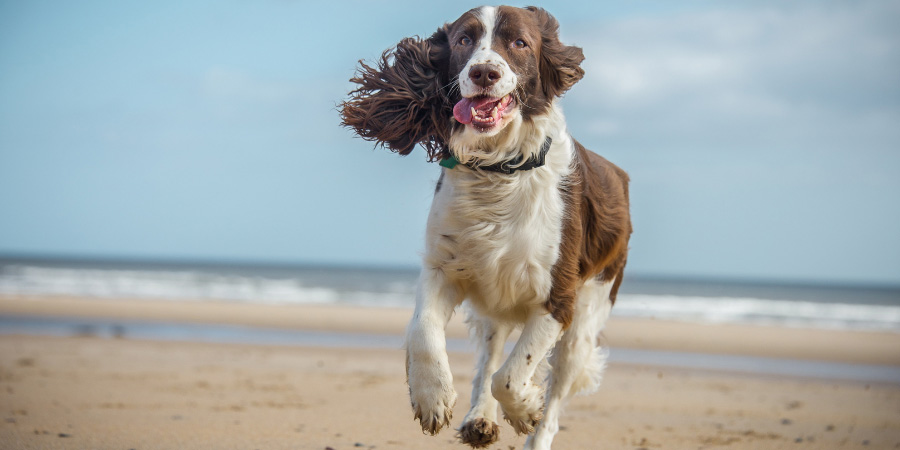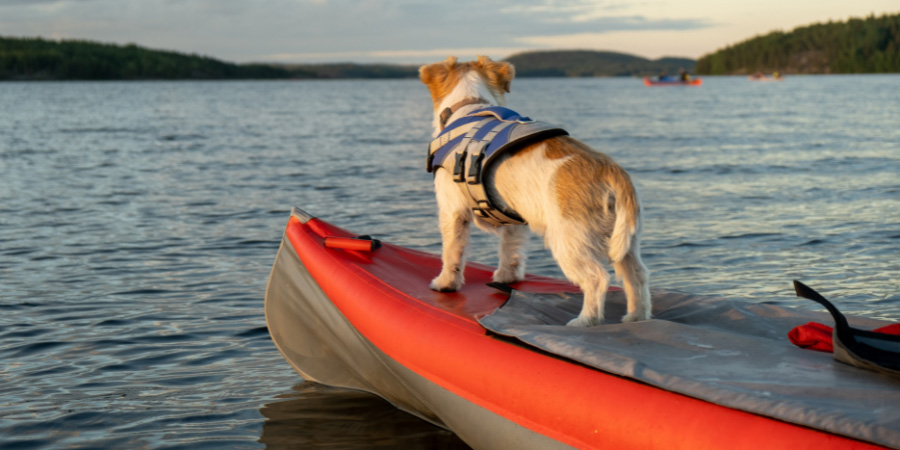While we wouldn’t recommend taking your cat or rabbits camping, it can be the ideal getaway for you and your dog. Camping holidays are good for walking and exploring, which is great for active dogs and active owners.
Are you wondering how to go camping with a dog? We’ve put together some tips to get you started.
Pick the right place.
Before thinking about activities and packing lists, you must carefully consider where your outdoor adventure will take place. Luckily, the UK has many dog-friendly camping and caravan sites, so you’ll be spoiled for choice.
Here are a few things to consider when deciding where to go:
- How far away is it from where you live? Can your dog cope with the journey?
- Are there lots of dog-friendly walks and activities nearby?
- What on-site facilities are available for people and dogs?
- Are there places on-site to safely dispose of your dog’s poo?
- Are there any places on-site where your dog wouldn’t be allowed?
- Is there anywhere you can safely let your dog play off-lead?
- If you plan to eat out, are there dog-friendly restaurants and pubs nearby?
- What kind of activities do you and your dog enjoy? Do you prefer spending days on the beach or hiking routes?
Read more: Safe car travel for pets
Work with the weather.

You should also consider the weather and how this will affect your pet. Some areas of the UK can be warmer than others at different times of the year, so it's important to check the weather forecast in the days leading up to your trip. If temperatures are soaring, take a rain check and rearrange your trip during a more suitable spell of weather.
Remember, cars, vans, tents, and caravans can quickly heat up to dangerous levels and can lead to heatstroke. For their safety, dogs should never be left alone inside a vehicle, tent, or caravan.
If temperatures are high, walking your dog when it’s cooler in the early morning/evening is best. On the hottest days, it is best to avoid walking them altogether. That might mean rearranging your hike or trip to the beach for a cooler day.
On the other hand, camping in constant rain is no fun… especially when it comes to managing those muddy paws! Necessary items for your pet include:
- A collapsible bowl and water bottle so your dog can have clean water to stay hydrated while walking.
- A towel (or two) to clean and dry them after a rain shower or muddy activity.
- Some comfy blankets to keep them warm during those colder nights.
- A cooling mat or collar will help keep them cool and hydrated when it’s warm.
- A form of shade device to give your dog a break from direct sunlight. Or set up a relaxation spot under the trees where it's breezy enough for them to stay cool and comfortable.
Master your dog’s packing list.
Your dog’s packing list is just as important as your own. When you go camping with your dog, you might need some extra things compared to staying in a hotel or holiday cottage.
In addition to the weather essentials we’ve already mentioned, here are some more pet must-haves you should take.
Food and feeding accessories
- Take enough dog food to last your entire trip. Big bags may not be practical, so we’d recommend pre-weighing what they’ll need and storing it in an airtight container away from paws reach!
- Food and water bowls.
- Bring dog treats or chews to keep them occupied and reward their good behaviour (in moderation, of course).
Health supplies
- Carry a doggy first-aid kit with you at all times to treat minor injuries, such as small cuts or grazes.
- Any medication they need for the duration of the trip.
- Any relaxants or anxiety relief products they will need to keep them calm (e.g. for car travel).
Other essentials
- Plenty of poo bags
- A waterproof bed that you can easily remove dirt and mud from.
- A selection of their favourite vet-approved dog toys to keep them entertained (and offer a sense of comfort).
- A reflective or flashing collar, lead, or harness for your dog to stay visible at night.
- If your dog is familiar with one, a tether can be a good addition. Especially if there's a chance they could take off at the first whiff of a barbecue!
Things to remember
- Make sure your dog always wears an ID tag with your contact details.
- Before leaving, contact the microchip database to check that your dog's information is correct.
- In case of an emergency accident or illness, save the contact number for a vet local to where you'll be staying in your phone.
- As well as knowing the whereabouts of the nearest vet, it may also be a good idea to locate your nearest pet shop. This way, you’ll know where to go should you need to buy or replace something for your pet while you're away.
Research the area and plan fun activities.

In the UK, we’re fortunate to have some beautiful countryside and woodland to explore and go on long walks. Sadly, not all dogs can walk for hours, but that doesn’t mean they can’t still enjoy a camping trip with you.
Do your research to see if there are other dog-friendly activities in the local area. If your pooch enjoys being in the water (and is used to it), you both could have fun paddle boarding or canoeing. Before any water activities, however, get your dog a life jacket and ensure they’re familiar with one so they feel safe and comfortable wearing it.
Some activities may not be dog-friendly, or specific places may ask that you keep your dog on a lead. It’s always best to check these things beforehand to ensure they work for you and your dog. Whatever your dog enjoys doing with you, ensure there will be plenty of opportunity for it.
Read more: The best dog-friendly beaches across the UK
Practice before you go.
If your dog has never gone camping, or it's been a while since you last went together, you might need to give them time to get used to it.
If you can, pitch your tent in the garden and allow your dog to get used to it well before your trip. Remember to reward them when they choose to go inside (you may need to use a bit of edible persuasion in the form of their favourite treat!).
Once they’re comfortable inside the tent, try setting it up as you would for camping with any roll mats, sleeping bags, or other equipment. Again, let them get used to this and make them a nice comfy bed inside that will be theirs. Scatter some treats in their bed to reward them for getting in and spending time there.
Once they’re happy, try spending a night in your tent. It may sound silly, but it will help your dog feel more comfortable with their surroundings.
Likewise, if you’re taking a campervan or caravan, your dog will still need time to get used to the experience! Practice in the same way you would a tent and set any boundaries from day one – for example, if your dog isn’t allowed on the seats in the campervan or in certain rooms in your caravan, they need to know this before going somewhere new and exciting.
Read more: Rewards-based training for dogs
Bring good manners.

Brushing up on your dog’s basic training before you go is a good idea. Campsites can be busy, exciting places, and even dogs who love being out and about sometimes find it hard to contain their excitement. Not everybody on the campsite may be a dog-lover, so your dog must respond to your commands.
Make sure your dog’s recall is really good before taking them away. When they’re coming back perfectly every time at home, practice in parks or other busier places to see how they cope with distractions. Make sure you have their favourite thing in the world while you practice to reward them (a small dog treat or a little boiled chicken works well).
Consider taking a tether if you think they may be a little too curious. This will enable you both to enjoy being outside your tent or caravan without the worry that your dog will run off to the other side of the campsite.
Always think about your pet’s safety.
A trip away often comes with plenty of excitement and much-needed distractions from everyday life. However, you must always pay attention to your pet’s safety to prevent them from becoming seriously ill or injured.
- Keep all toxic food and drinks safely secure and away from paws reach.
- Light fires and barbeques well away from your tent, and ensure your dog is at a safe distance at all times.
- Be aware of poisonous plants that may harm your dog.
- Be aware of the dangers of blue-green algae if you are camping or walking near waterways.
- Create a safe, comfortable space for your dog to relax in while you are having downtime at the campsite. This can include their bed, favourite toy, and clean drinking water so they can rest.
Read next: Planning the perfect dog-friendly staycation
